In last week's prediction for the week ahead I raised the question of how would stocks do in an environment of rising rates? This kept alive my streak of guessing the market theme for the coming week, especially since rates took another leg higher and stocks seemed to cope with the news.
The coming week provides a new challenge. While many will dwell on the popular Fed theme (where so many have opinions without either supporting data or a track record) my own sense is that this theme is aging. The media will embrace a shift to news about corporate earnings, but still with some competing themes.
Will earnings measure up?
We know that expectations have been lowered and that pre-announcements have been very negative. As I consider the coming week, I see several competing themes:
- Technical Analysis. The TV commentators were breathlessly watching S&P 1625 as the market closed. At the start of Friday's trading it appeared that stocks would blow through this level. Art Cashin said there was a "delayed reaction" as bosses called in from the Hamptons to point out the increase in the ten-year note yield. Art was not around at the end of the day. He astutely noted that traders were consulting train schedules shortly after the opening, so no one knows for sure how to interpret the close.
- FedSpeak background. There is an ongoing battle (see last week's discussion) between market participants, policymakers, academics, and journalists. Each has a different perspective and all have merit. I do not want to repeat last week's analysis, so let me highlight the best new idea. Tim Duy (another Kauffman friend whose brain I shamelessly picked at the conference) continues to do outstanding work on the Fed. He concludes that the Fed wants a responsible exit and is trying to communicate what this means. Traders who have a knee-jerk reaction to the first sign of a reduction in the rate of Fed easing will find it alarming. I recommend a more careful reading.
- Street expectations remain very negative. Many big hedge fund players have gotten the market wrong, as Barry Ritholtz notes. Barry also highlights the continuing bearish views from the sell-side community, illustrated by this chart:
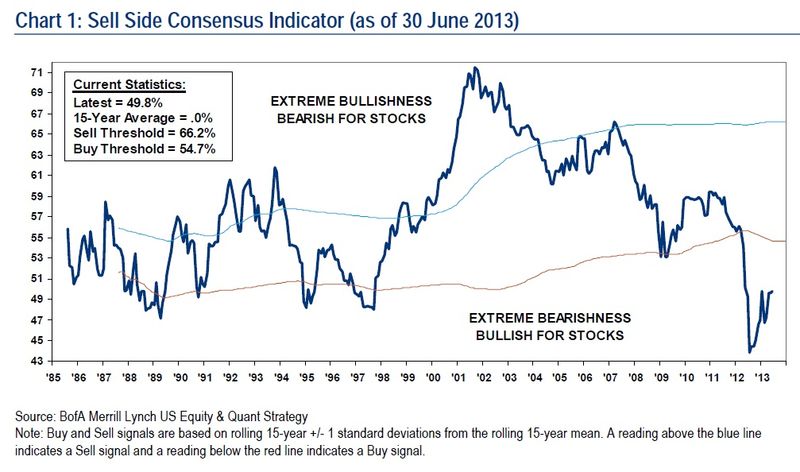
- Earnings expectations are low, as noted in Barron's.
"School's out and the report cards are on the way. More than a few parents have been warned that their kids' performances are falling short of expectations, so with Mom and Dad bracing for Cs and Ds, a B will be greeted like an A."
Background on "Weighing the Week Ahead"
There are many good lists of upcoming events. One source I regularly follow is the weekly calendar from Investing.com. For best results you need to select the date range from the calendar displayed on the site. You will be rewarded with a comprehensive list of data and events from all over the world. It takes a little practice, but it is worth it.
In contrast, I highlight a smaller group of events. My theme is an expert guess about what we will be watching on TV and reading in the mainstream media. It is a focus on what I think is important for my trading and client portfolios. Each week I consider the upcoming calendar and the current market, predicting the main theme we should expect. This step is an important part of my trading preparation and planning. It takes more hours than you can imagine.
My record is pretty good. If you review the list of titles it looks like a history of market concerns. Wrong! The thing to note is that I highlighted each topic the week before it grabbed the attention. I find it useful to reflect on the key theme for the week ahead, and I hope you will as well.
This is unlike my other articles where I develop a focused, logical argument with supporting data on a single theme. Here I am simply sharing my conclusions. Sometimes these are topics that I have already written about, and others are on my agenda. I am putting the news in context.
Readers often disagree with my conclusions. Do not be bashful. Join in and comment about what we should expect in the days ahead. This weekly piece emphasizes my opinions about what is really important and how to put the news in context. I have had great success with my approach, but feel free to disagree. That is what makes a market!
Last Week's Data
Each week I break down events into good and bad. Often there is "ugly" and on rare occasions something really good. My working definition of "good" has two components:
- The news is market-friendly. Our personal policy preferences are not relevant for this test. And especially -- no politics.
- It is better than expectations.
This was a very good week on the economic front.
- Home prices are up 12.2% year-over-year. Data from CoreLogic analyzed by Calculated Risk. See the entire post for analysis of this strong report.
- The Eurozone PMI moved a little higher. The 48.7 reading is still in the contraction range, but the "Recession Eases" via the report from Global Economic Intersection.
- Light vehicle sales continued to be strong – four years of double-digit growth. Scott Grannis has the story and this informative chart:
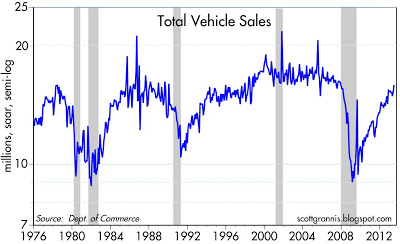 Gas Prices declined again, now down 29 cents from the recent high in February. See the analysis from Doug Short, showing the relationship with the overall CPI index and his typically first-rate charts. Here is a good example:
Gas Prices declined again, now down 29 cents from the recent high in February. See the analysis from Doug Short, showing the relationship with the overall CPI index and his typically first-rate charts. Here is a good example: 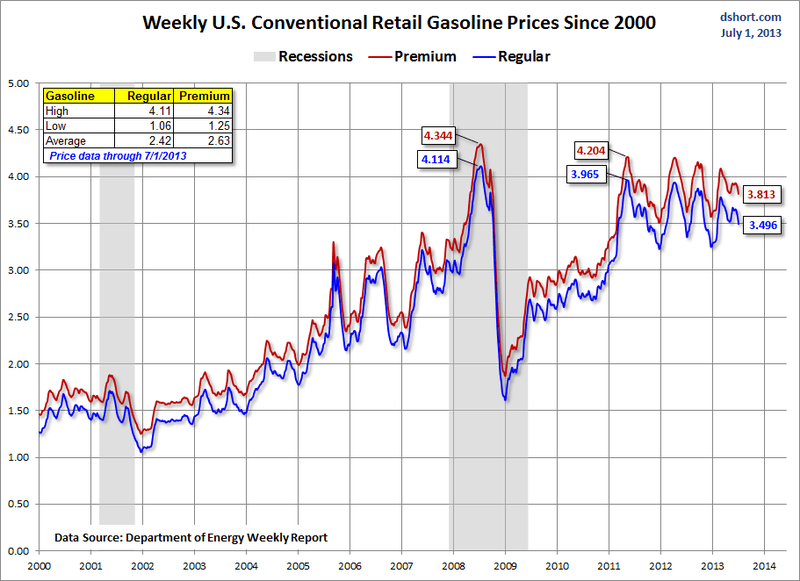
- Employment gains beat expectations – but not by too much. Joe Weisenthal calls the report the "Mother of all Goldilocks." Here are the highlights from WSJ's Real Time Economics Blog. Even David Rosenberg finds 10 reasons to love the jobs report. Labor force participation also increased. Some criticized the gain in part-time jobs at the expense of full-time employment. The Bonddad Blog showed the error of that assertion by documenting the increase in aggregate hours worked.
There was a little bad news. Feel free to add in the comments anything you think I missed!
- The June ISM Services index declined to 52.2, missing expectations. Steven Hansen analyzes the sub-indexes, concluding that the story is even worse.
- Bullish sentiment spiked higher, the biggest one-week jump since March in the AAII index. Bespoke has the story, helpful commentary, and a chart showing the relationship with the S&P 500. Most observers see this as a contrarian indicator, so that is how I have scored it. Take a look for yourself:
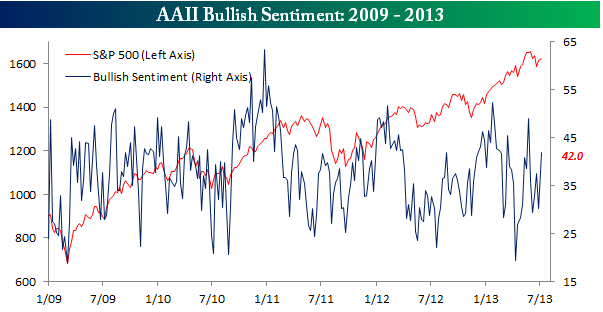
- The trade deficit for May was much higher than expected at $45 billion. Brian Wesbury sees the bright side in the resilience of the consumer and the overall increase in trade. Meanwhile, the decline in exports implies a reduction in real 2nd quarter GDP of almost one full point. We can expect consensus economic forecasts for the quarter to move lower.
ETF tracking may not be as expected. Investors may be losing on both entry and exit. Blackrock offers an explanation, but Izabella Kaminska at FTAlphaville is all over this story. The story also has important background links. She writes as follows:
"Anyway, it seems the lesson here from Blackrock is that if you've been left holding an illiquid muni security, EM or high-yield bond that you just can't shift, then you are the greater fool for not appreciating that price discovery no longer happens in these markets directly, but in related ETFs. Shame on you for not owning those instead."
Noteworthy
There are occasionally items that do not fit my normal classification, but deserve our attention.
- Small businesses get more time to implement ObamaCare. My Kauffman Conference friend Ezra Klein, in a great story on this subject, suggests that the delay in implementation should be made permanent. My own experience in public policy is consistent with his analysis. Complex programs include many elements that might not work or will have unforeseen consequences. Discovering this early and changing course is a good move which actually has a very small effect. As investors, we now need to figure out how this affects our health care positions – if at all.
It is important to keep the current news in perspective. I am always searching for the best indicators for our weekly snapshot. I make changes when the evidence warrants. At the moment, my weekly snapshot includes these important summary indicators:
- For financial risk, theSt. Louis Financial Stress Index.
- An updated analysis of recession probability from key sources.
- For market trends, the key measures from our "Felix" ETF model.
The SLFSI reports with a one-week lag. This means that the reported values do not include last week's market action. The SLFSI has recently edged a bit higher, reflecting increased market volatility. It remains at historically low levels, well out of the trigger range of my pre-determined risk alarm. This is an excellent tool for managing risk objectively, and it has suggested the need for more caution. Before implementing this indicator our team did extensive research, discovering a "warning range" that deserves respect. We identified a reading of 1.1 or higher as a place to consider reducing positions.
The SLFSI is not a market-timing tool, since it does not attempt to predict how people will interpret events. It uses data, mostly from credit markets, to reach an objective risk assessment. The biggest profits come from going all-in when risk is high on this indicator, but so do the biggest losses.
Recession Odds
I feature the C-Score, a weekly interpretation of the best recession indicator I found, Bob Dieli's "aggregate spread." I have now added a series of videos, where Dr. Dieli explains the rationale for his indicator and how it applied in each recession since the 50's. I have organized this so that you can pick a particular recession and see the discussion for that case. Those who are skeptics about the method should start by reviewing the video for that recession. Anyone who spends some time with this will learn a great deal about the history of recessions from a veteran observer.
I have promised another installment on how I use Bob's information to improve investing. I hope to have that soon. Meanwhile, anyone watching the videos will quickly learn that the aggregate spread (and the C Score) provides an early warning. Bob also has a collection of coincident indicators and is always questioning his own methods.
I also feature RecessionAlert, which combines a variety of different methods, including the ECRI, in developing a Super Index. They offer a free sample report. Anyone following them over the last year would have had useful and profitable guidance on the economy. RecessionAlert has developed a comprehensive package of economic forecasting and market indicators, well worth your consideration.
Georg Vrba's four-input recession indicator is also benign. Here is his latest update where he concludes, "Based on the historic patterns of the unemployment rate indicators prior to recessions one can reasonably conclude that the U.S. economy is not likely to go into recession anytime soon." Georg has other excellent indicators for stocks, bonds, and precious metals at iMarketSignals. This chart illustrates Georg's unemployment method:
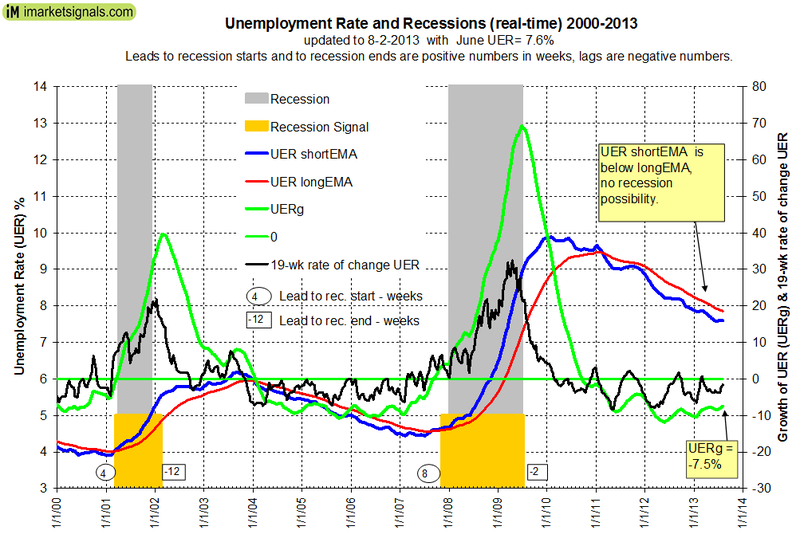
Unfortunately, and despite the inaccuracy of their forecast, the mainstream media features the ECRI. Doug Short has excellent continuing coverage of the ECRI recession prediction, now over 18 months old. Doug updates all of the official indicators used by the NBER and also has a helpful list of articles about recession forecasting. His latest comment points out that the public data series has not been helpful or consistent with the announced ECRI posture. Doug also continues to refresh the best chart update of the major indicators used by the NBER in recession dating.
The average investor has lost track of this long ago, and that is unfortunate. The original ECRI claim and the supporting public data was expensive for many. The reason that I track this weekly, emphasizing the best methods, is that it is important for corporate earnings and for stock prices. It has been worth the effort for me, and for anyone reading each week.
Readers might also want to review my Recession Resource Page, which explains many of the concepts people get wrong.

Our "Felix" model is the basis for our "official" vote in the weekly Ticker Sense Blogger Sentiment Poll. We have a long public record for these positions. Last week we switched to a bearish position, but it was a close call. This week we have switched back to neutral, and it is still a close call. The inverse ETFs are more highly rated than positive sectors by a small margin, but remain in the penalty box. These are one-month forecasts for the poll, but Felix has a three-week horizon. Felix's ratings have improved a bit. The penalty box percentage measures our confidence in the forecast. A high rating means that most ETFs are in the penalty box, so we have less confidence in the overall ratings. That measure remains elevated, so we have less confidence in short-term trading.
[For more on the penalty box see this article. For more on the system ratings, you can write to etf at newarc dot com for our free report package or to be added to the (free) weekly ETF email list. You can also write personally to me with questions or comments, and I'll do my best to answer.]
The Week Ahead
After last week's crowded data calendar, this week is much lighter.
The "A List" includes the following:
- Initial jobless claims (Th). Employment will continue as the focal point in evaluating the economy, and this is the most responsive indicator.
- FOMC minutes (W). Because of the speeches in the aftermath of the last Fed meeting, there will be special interest in the official account of the deliberations.
- Michigan sentiment index (F). This is the preliminary reading for July. It is a good concurrent indicator for employment and spending.
- PPI (F). Inflation has been so tame that it has little relevance – so far.
The biggest news of the week will be the opening of earnings season, with reports and updates throughout the week, including JPM and WFC on Friday.
How to Use the Weekly Data Updates
In the WTWA series I try to share what I am thinking as I prepare for the coming week. I write each post as if I were speaking directly to one of my clients. Each client is different, so I have five different programs ranging from very conservative bond ladders to very aggressive trading programs. It is not a "one size fits all" approach.
To get the maximum benefit from my updates you need to have a self-assessment of your objectives. Are you most interested in preserving wealth? Or like most of us, do you still need to create wealth? How much risk is right for your temperament and circumstances?
My weekly insights often suggest a different course of action depending upon your objectives and time frames. They also accurately describe what I am doing in the programs I manage.
Insight for Traders
Felix has shifted back to a neutral posture. Our trading accounts never actually went short. For some time we had no position. Then we were short bonds. Most recently we have been long oil via USO. We are doing a three-week forecast, but we update the model every day and trade accordingly. It is fair to say that Felix remains cautious about the next few weeks. Felix did well to avoid the premature correction calls that have been prevalent since the first few days of 2013, accompanied by various slogans and omens.
Insight for Investors
This is a time of danger for investors – a potential market turning point. My recent themes have been accurate and are still quite valid. If you have not followed the links, find time to give yourself a mid-year checkup. You can follow the steps below:
- What NOT to do
- Find a safer source of yield: Take what the market is giving you!
- Balance risk and reward
- Get Started
For investors it was a different story. If you had your shopping list, there were good opportunities to buy stocks. For those following our enhanced yield approach you had both the chance to set new positions and to sell calls against old ones. I was also delighted to see recognition for Chuck Carnevale's F.A.S.T. Graphs site in this week's Barron's. I include a visit to his site as part of every stock evaluation and you should, too. Chuck graciously provides ideas as well as his more recent data in his frequent articles. This thoughtful post is a recent example.
And finally, we have collected some of our recent recommendations in a new investor resource page -- a starting point for the long-term investor. (Comments and suggestions welcome. I am trying to be helpful and I love feedback).
Final Thought
As usual I share my thinking and conclusions with the understanding that each point deserves more discussion. While I am "thinking out loud" I always try to elaborate in the comments when there are questions.
- I expect the normal pattern of companies beating reduced expectations.
- I really like the Friday market action. It is especially encouraging that last year's relationship of weak dollar, strong stocks disappeared. The dollar is at a three-year high.
- Many analysts are looking forward – on the economy and on earnings.
A key element is to avoid the fixation on the Fed. The idea that the Fed determines long-term interest rates is rapidly being proven wrong. James Hamilton shows (It's not just the Fed) that interest rates actually increased after the announcement of both QE2 and QE3. He writes, "It's worth emphasizing that the recent rise in interest rates has been a global phenomenon, not just something seen in the United States."
I have demonstrated that Fed buying is only 1% of daily trading in the cash markets. Nearly everyone confuses net new issuance of debt, total new issuance, and the float. This is a big mistake, and it can be a costly one.
The takeaway for investors is to look for companies that will thrive in an environment of rising interest rates and a strong dollar.
